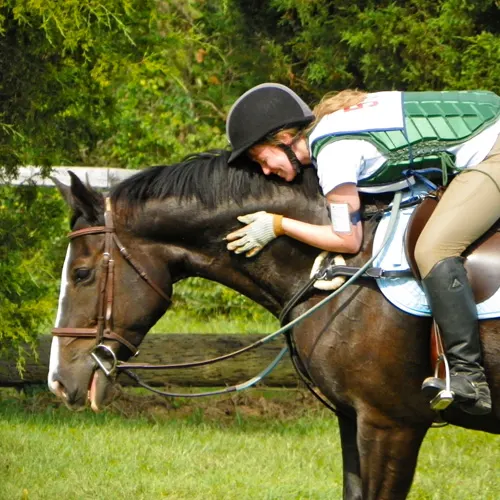For most of my training career with this Human, I have pretty much run our cross-country courses solo. How else can you look at it, when she has yet to keep from fainting somewhere between the start box and finish flags?
At long last however, I’ve begun convincing her to keep her eyes open as I step gingerly over the 2” by 4”s and half-decayed straw bales we typically encounter in the starter division, and we’re beginning to school over new types of questions.
Questions that are actually, you know, questions.
On one hand, I am overjoyed that I no longer snore my way through the cross-country portion of our horse trials, but on the other, these opportunities have required me to develop more complicated answers as the complexity of the questions increases.
Here are my initial impressions on the best way to school a Human through a typical starter or beginner novice cross-country course:
ADVERTISEMENT
- Logs: Logs are a good way to teach the Human about the unpredictability of life. Some logs are simply discarded parts of the forest, decaying peacefully with no threat to the surrounding ecosystem.
However, experts estimate five percent of logs harbor snakes, skunks, and all manner of terrifying fauna, which should be avoided desperately at any cost.
The trouble is, you can’t always tell the difference until you get right up on them, and even then, you may need someone with better eyesight to move in for a closer look first. When I find this necessary, I like to offer the Human first dibs at brushing up on her ecology. By herself. Feet first.
- Brush: WHAT is the deal with these things?
I’m not actually dim enough to think I need to jump over the outer portion of the evergreen, so is the purpose just to scrape up my shins if the Human adjusted my boots incorrectly?
Anyway, I think the idea is that it’s meant to be an optical illusion for the Human, causing her to think we’re suddenly hurtling toward a training level fence (if only). I like to offset this by opening my jaw, grabbing the bit between my teeth, and carving out as deep a spot as I can.
This might scare the stuffing out of her, but it gives her more time to let her eyes adjust.
- Coops: These are pretty wide and symmetrical, and therefore tend to be a good chance to teach the Human about the importance of riding the center of the fence.
While she’s up there hyperventilating or something, I’ve noticed she lets the reins go a bit slack. While I realize I’m supposed to aim for the middle of the jump, I get a little bored playing hunter/jumper and enjoy skimming the edges of the red or white flags until she mans up.
Oopsie, looks like we missed that one. Oh, well. What’s 20 more points when your dressage score is in the 50s, right, buttercup?
- Water: Clearly designed to be a soothing experience for me, the exhausted Quadruped instructor.
I like to enjoy the precious minutes (/hours) spent crossing a shallow water obstacle—stop for a good splash, count the ripples my feet make, look for minnows, and maybe even get in a good roll. They say sand is an excellent exfoliant, and I’ve always suspected the stuff at the bottom of water obstacles would feel great on my withers, if I could rub the pesky chick and her tack off first.
This demonstrates for her how much well-adjusted beings value taking time out of their busy days to practice self-care.
- Ditches: These exist to teach the Human to ride forward. As small as they tend to be, I really think it’s easier for me to do an extended trot through the middle of them when the bottom is flat enough, so that’s my Plan A unless she uses enough leg that I have to canter.
Amusingly, this sometimes prompts the Human to prepare for a lift-off that never happens, causing her to bounce off the saddle, which sometimes inspires a case of hiccups.
- Barrels: A good antidote for the flop hiccups. I am very careful with my knees, but I don’t mind letting a hoof clunk the fronts of these on the way up, reminding her that these are solid obstacles that require her complete attention. That usually scares the hiccups right out of her.















